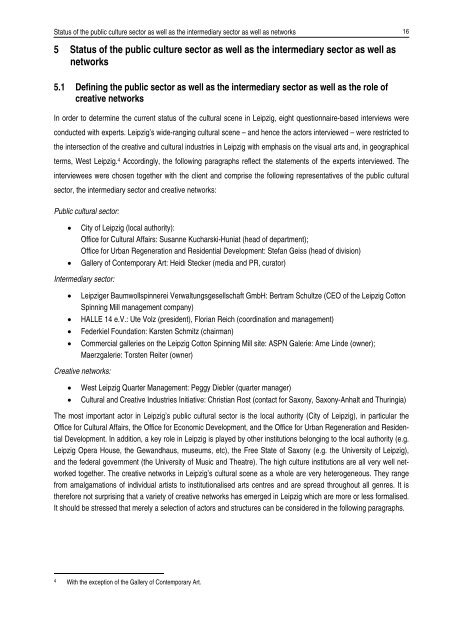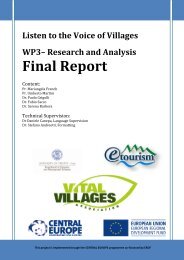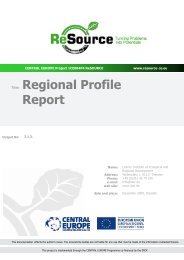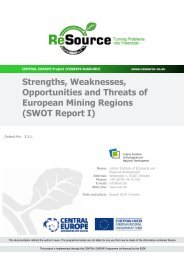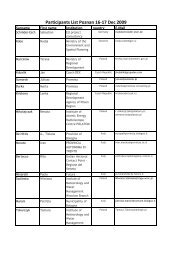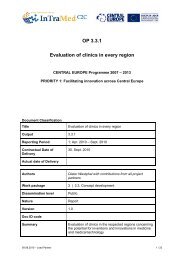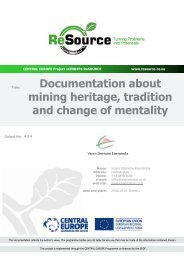SWOT-Analysis of Halle 14 in the Cotton Spinning ... - Central Europe
SWOT-Analysis of Halle 14 in the Cotton Spinning ... - Central Europe
SWOT-Analysis of Halle 14 in the Cotton Spinning ... - Central Europe
Create successful ePaper yourself
Turn your PDF publications into a flip-book with our unique Google optimized e-Paper software.
Status <strong>of</strong> <strong>the</strong> public culture sector as well as <strong>the</strong> <strong>in</strong>termediary sector as well as networks<br />
5 Status <strong>of</strong> <strong>the</strong> public culture sector as well as <strong>the</strong> <strong>in</strong>termediary sector as well as<br />
networks<br />
5.1 Def<strong>in</strong><strong>in</strong>g <strong>the</strong> public sector as well as <strong>the</strong> <strong>in</strong>termediary sector as well as <strong>the</strong> role <strong>of</strong><br />
creative networks<br />
In order to determ<strong>in</strong>e <strong>the</strong> current status <strong>of</strong> <strong>the</strong> cultural scene <strong>in</strong> Leipzig, eight questionnaire-based <strong>in</strong>terviews were<br />
conducted with experts. Leipzig’s wide-rang<strong>in</strong>g cultural scene – and hence <strong>the</strong> actors <strong>in</strong>terviewed – were restricted to<br />
<strong>the</strong> <strong>in</strong>tersection <strong>of</strong> <strong>the</strong> creative and cultural <strong>in</strong>dustries <strong>in</strong> Leipzig with emphasis on <strong>the</strong> visual arts and, <strong>in</strong> geographical<br />
terms, West Leipzig. 4 Accord<strong>in</strong>gly, <strong>the</strong> follow<strong>in</strong>g paragraphs reflect <strong>the</strong> statements <strong>of</strong> <strong>the</strong> experts <strong>in</strong>terviewed. The<br />
<strong>in</strong>terviewees were chosen toge<strong>the</strong>r with <strong>the</strong> client and comprise <strong>the</strong> follow<strong>in</strong>g representatives <strong>of</strong> <strong>the</strong> public cultural<br />
sector, <strong>the</strong> <strong>in</strong>termediary sector and creative networks:<br />
Public cultural sector:<br />
• City <strong>of</strong> Leipzig (local authority):<br />
Office for Cultural Affairs: Susanne Kucharski-Huniat (head <strong>of</strong> department);<br />
Office for Urban Regeneration and Residential Development: Stefan Geiss (head <strong>of</strong> division)<br />
• Gallery <strong>of</strong> Contemporary Art: Heidi Stecker (media and PR, curator)<br />
Intermediary sector:<br />
• Leipziger Baumwollsp<strong>in</strong>nerei Verwaltungsgesellschaft GmbH: Bertram Schultze (CEO <strong>of</strong> <strong>the</strong> Leipzig <strong>Cotton</strong><br />
Sp<strong>in</strong>n<strong>in</strong>g Mill management company)<br />
• HALLE <strong>14</strong> e.V.: Ute Volz (president), Florian Reich (coord<strong>in</strong>ation and management)<br />
• Federkiel Foundation: Karsten Schmitz (chairman)<br />
• Commercial galleries on <strong>the</strong> Leipzig <strong>Cotton</strong> Sp<strong>in</strong>n<strong>in</strong>g Mill site: ASPN Galerie: Arne L<strong>in</strong>de (owner);<br />
Maerzgalerie: Torsten Reiter (owner)<br />
Creative networks:<br />
• West Leipzig Quarter Management: Peggy Diebler (quarter manager)<br />
• Cultural and Creative Industries Initiative: Christian Rost (contact for Saxony, Saxony-Anhalt and Thur<strong>in</strong>gia)<br />
The most important actor <strong>in</strong> Leipzig’s public cultural sector is <strong>the</strong> local authority (City <strong>of</strong> Leipzig), <strong>in</strong> particular <strong>the</strong><br />
Office for Cultural Affairs, <strong>the</strong> Office for Economic Development, and <strong>the</strong> Office for Urban Regeneration and Residential<br />
Development. In addition, a key role <strong>in</strong> Leipzig is played by o<strong>the</strong>r <strong>in</strong>stitutions belong<strong>in</strong>g to <strong>the</strong> local authority (e.g.<br />
Leipzig Opera House, <strong>the</strong> Gewandhaus, museums, etc), <strong>the</strong> Free State <strong>of</strong> Saxony (e.g. <strong>the</strong> University <strong>of</strong> Leipzig),<br />
and <strong>the</strong> federal government (<strong>the</strong> University <strong>of</strong> Music and Theatre). The high culture <strong>in</strong>stitutions are all very well networked<br />
toge<strong>the</strong>r. The creative networks <strong>in</strong> Leipzig’s cultural scene as a whole are very heterogeneous. They range<br />
from amalgamations <strong>of</strong> <strong>in</strong>dividual artists to <strong>in</strong>stitutionalised arts centres and are spread throughout all genres. It is<br />
<strong>the</strong>refore not surpris<strong>in</strong>g that a variety <strong>of</strong> creative networks has emerged <strong>in</strong> Leipzig which are more or less formalised.<br />
It should be stressed that merely a selection <strong>of</strong> actors and structures can be considered <strong>in</strong> <strong>the</strong> follow<strong>in</strong>g paragraphs.<br />
4 With <strong>the</strong> exception <strong>of</strong> <strong>the</strong> Gallery <strong>of</strong> Contemporary Art.<br />
16


